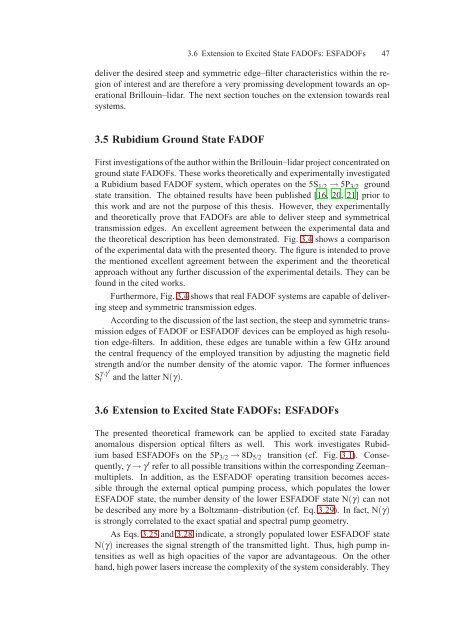Assessment of a Rubidium ESFADOF Edge-Filter as ... - tuprints
Assessment of a Rubidium ESFADOF Edge-Filter as ... - tuprints
Assessment of a Rubidium ESFADOF Edge-Filter as ... - tuprints
You also want an ePaper? Increase the reach of your titles
YUMPU automatically turns print PDFs into web optimized ePapers that Google loves.
3.6 Extension to Excited State FADOFs: <strong>ESFADOF</strong>s 47<br />
deliver the desired steep and symmetric edge–filter characteristics within the region<br />
<strong>of</strong> interest and are therefore a very promissing development towards an operational<br />
Brillouin–lidar. The next section touches on the extension towards real<br />
systems.<br />
3.5 <strong>Rubidium</strong> Ground State FADOF<br />
First investigations <strong>of</strong> the author within the Brillouin–lidar project concentrated on<br />
ground state FADOFs. These works theoretically and experimentally investigated<br />
a <strong>Rubidium</strong> b<strong>as</strong>ed FADOF system, which operates on the 5S 1/2 → 5P 3/2 ground<br />
state transition. The obtained results have been published [16, 20, 21] prior to<br />
this work and are not the purpose <strong>of</strong> this thesis. However, they experimentally<br />
and theoretically prove that FADOFs are able to deliver steep and symmetrical<br />
transmission edges. An excellent agreement between the experimental data and<br />
the theoretical description h<strong>as</strong> been demonstrated. Fig. 3.4 shows a comparison<br />
<strong>of</strong> the experimental data with the presented theory. The figure is intended to prove<br />
the mentioned excellent agreement between the experiment and the theoretical<br />
approach without any further discussion <strong>of</strong> the experimental details. They can be<br />
found in the cited works.<br />
Furthermore, Fig. 3.4 shows that real FADOF systems are capable <strong>of</strong> delivering<br />
steep and symmetric transmission edges.<br />
According to the discussion <strong>of</strong> the l<strong>as</strong>t section, the steep and symmetric transmission<br />
edges <strong>of</strong> FADOF or <strong>ESFADOF</strong> devices can be employed <strong>as</strong> high resolution<br />
edge-filters. In addition, these edges are tunable within a few GHz around<br />
the central frequency <strong>of</strong> the employed transition by adjusting the magnetic field<br />
strength and/or the number density <strong>of</strong> the atomic vapor. The former influences<br />
S γ,γ′<br />
r<br />
and the latter N(γ).<br />
3.6 Extension to Excited State FADOFs: <strong>ESFADOF</strong>s<br />
The presented theoretical framework can be applied to excited state Faraday<br />
anomalous dispersion optical filters <strong>as</strong> well. This work investigates <strong>Rubidium</strong><br />
b<strong>as</strong>ed <strong>ESFADOF</strong>s on the 5P 3/2 → 8D 5/2 transition (cf. Fig. 3.1). Consequently,<br />
γ → γ ′ refer to all possible transitions within the corresponding Zeeman–<br />
multiplets. In addition, <strong>as</strong> the <strong>ESFADOF</strong> operating transition becomes accessible<br />
through the external optical pumping process, which populates the lower<br />
<strong>ESFADOF</strong> state, the number density <strong>of</strong> the lower <strong>ESFADOF</strong> state N(γ) can not<br />
be described any more by a Boltzmann–distribution (cf. Eq. 3.29). In fact, N(γ)<br />
is strongly correlated to the exact spatial and spectral pump geometry.<br />
As Eqs. 3.25 and 3.28 indicate, a strongly populated lower <strong>ESFADOF</strong> state<br />
N(γ) incre<strong>as</strong>es the signal strength <strong>of</strong> the transmitted light. Thus, high pump intensities<br />
<strong>as</strong> well <strong>as</strong> high opacities <strong>of</strong> the vapor are advantageous. On the other<br />
hand, high power l<strong>as</strong>ers incre<strong>as</strong>e the complexity <strong>of</strong> the system considerably. They
















